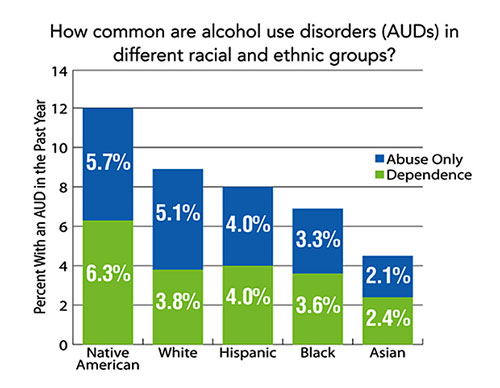Return To: Home
»
By the Numbers
Every Picture Tells (Part of) a Story

The picture of alcohol abuse and dependence among different racial and ethnic groups in the United States is complex and is changing in conjunction with the rapidly shifting national demographics. As shown in the chart, the prevalence of alcohol use disorders (AUDs) varies among different groups. Rates of past-year AUDs range from a high of nearly 12 percent among Native Americans to a low of 4.5 percent among Asian Americans. In between, rates among Blacks, Hispanics, and Whites range from 7 to 9 percent, close to the average of 8.5 percent for all U.S. adults (Grant et al., 2006).
The big-picture statistics tell only part of the story. Studies have also teased apart racial and ethnic differences in drinking patterns, the severity of AUDs, social and medical consequences, treatment usage, and more. Among the findings:
- Dependence severity: Alcohol dependence is less common among Blacks and Hispanics compared to Whites, but Blacks and Hispanics are more likely than Whites to have severe dependence that persists or recurs (Dawson et al., 2005).
- Medical consequences: Black men have higher rates of alcohol-related pancreatic disease and esophageal cancer than White men. Overall, Hispanic men have the highest rates of death from liver cirrhosis (Chartier and Caetano, 2010). It’s important to consider both race and ethnicity, however, as White Hispanic men have the highest cirrhosis death rates and Black Hispanic men the lowest (Dawson et al., 2001).
- Treatment usage: Compared with Whites, Blacks and Hispanics are less likely to use private health care for AUDs, and Hispanics are less likely to use alcohol treatment programs. The more severe the alcohol problem, the less likely Blacks and Hispanics are to use alcohol services (Chartier and Caetano, 2011).
Adding to the complexity, there are differences not only across groups but also within groups. For example, Hispanics from different countries of origin have different rates of AUDs. These rates, in turn, are influenced by birthplace, with more AUDs found among U.S.-born rather than foreign-born Hispanics (Alegria et al., 2006).
Moreover, rates change with time. Trend data have shown, for example, that alcohol abuse increased between 1992 and 2002 among White and Black men and women, Hispanic men (Caetano et al., 2011), and young adult Asian women (Grant, 2006). During the same time frame, alcohol dependence decreased among White and Hispanic men (Caetano et al., 2011) and increased among some young adult minorities, including Black women and Asian men (Grant, 2006).
A broad goal of all of this research is to help pinpoint who is at risk for alcohol-related problems. Continued work is needed to fill in the picture more completely, so that effective prevention and treatment programs can be targeted to specific groups and subgroups that are in need. This knowledge will become increasingly critical as the United States moves toward a population that consists primarily of people of racial and ethnic minority heritage.
Sources:
Alegria M, Canino G, Stinson FS, Grant BF. Nativity and DSM-IV psychiatric disorders among Puerto Ricans, Cuban Americans, and non-Latino Whites in the United States: Results from the National Epidemiologic Survey on Alcohol and Related Conditions. Journal of Clinical Psychiatry. 2006 Jan;67(1):56-65.
Dawson DA, Grant BF, Stinson FS, Chou PS, Huang B, Ruan WJ. Recovery from DSM-IV alcohol dependence: United States, 2001-2002. Addiction. 2005 Mar;100(3):281-92.
Caetano R, Baruah B, Chartier KG. Ten-year trends (1992-2002) in sociodemographic predictors and indicators of alcohol abuse and dependence among Whites, Blacks, and Hispanics. Alcoholism: Clinical and Experimental Research. 2011 Aug;35(8):1-9.
Chartier K, Caetano R. Ethnicity and health disparities in alcohol research. Alcohol Research & Health. 2010;33(1-2):152-160.
Chartier KG, Caetano R. Trends in alcohol services utilization from 1991-1992 to 2001-2002: Ethnic group differences in the U.S. population. Alcoholism: Clinical and Experimental Research. 2011 Aug;35(8):1485-97.
Grant BF, Dawson DA, Stinson FS, Chou SP, Dufour MC, Pickering RP. The 12-month prevalence and trends in DSM-IV alcohol abuse and dependence: United States, 1991-1992 and 2001-2002. Alcohol Research & Health. 2006;29(3):79-91.
Stinson FS, Grant BF, Dufour MC. The critical dimension of ethnicity in liver cirrhosis mortality statistics. Alcoholism: Clinical and Experimental Research. 2001 Aug;25(8):1181-87.